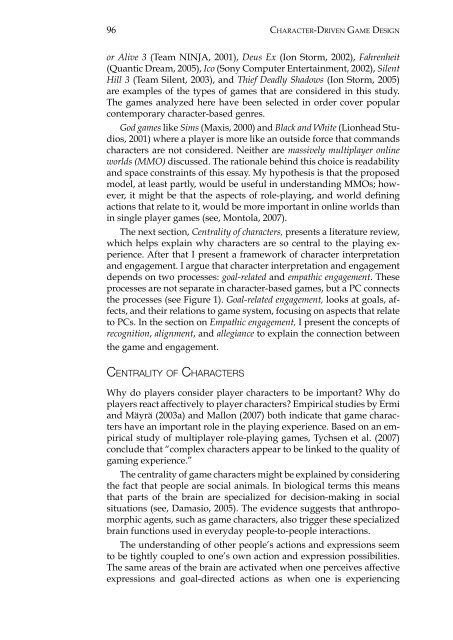Character Driven Game Design
Character Driven Game Design
Character Driven Game Design
You also want an ePaper? Increase the reach of your titles
YUMPU automatically turns print PDFs into web optimized ePapers that Google loves.
96<br />
<strong>Character</strong>-<strong>Driven</strong> <strong>Game</strong> <strong>Design</strong><br />
or Alive 3 (Team NINJA, 2001), Deus Ex (Ion Storm, 2002), Fahrenheit<br />
(Quantic Dream, 2005), Ico (Sony Computer Entertainment, 2002), Silent<br />
Hill 3 (Team Silent, 2003), and Thief Deadly Shadows (Ion Storm, 2005)<br />
are examples of the types of games that are considered in this study.<br />
The games analyzed here have been selected in order cover popular<br />
contemporary character-based genres.<br />
God games like Sims (Maxis, 2000) and Black and White (Lionhead Studios,<br />
2001) where a player is more like an outside force that commands<br />
characters are not considered. Neither are massively multiplayer online<br />
worlds (MMO) discussed. The rationale behind this choice is readability<br />
and space constraints of this essay. My hypothesis is that the proposed<br />
model, at least partly, would be useful in understanding MMOs; however,<br />
it might be that the aspects of role-playing, and world defining<br />
actions that relate to it, would be more important in online worlds than<br />
in single player games (see, Montola, 2007).<br />
The next section, Centrality of characters, presents a literature review,<br />
which helps explain why characters are so central to the playing experience.<br />
After that I present a framework of character interpretation<br />
and engagement. I argue that character interpretation and engagement<br />
depends on two processes: goal-related and empathic engagement. These<br />
processes are not separate in character-based games, but a PC connects<br />
the processes (see Figure 1). Goal-related engagement, looks at goals, affects,<br />
and their relations to game system, focusing on aspects that relate<br />
to PCs. In the section on Empathic engagement, I present the concepts of<br />
recognition, alignment, and allegiance to explain the connection between<br />
the game and engagement.<br />
Centrality of <strong>Character</strong>s<br />
Why do players consider player characters to be important? Why do<br />
players react affectively to player characters? Empirical studies by Ermi<br />
and Mäyrä (2003a) and Mallon (2007) both indicate that game characters<br />
have an important role in the playing experience. Based on an empirical<br />
study of multiplayer role-playing games, Tychsen et al. (2007)<br />
conclude that “complex characters appear to be linked to the quality of<br />
gaming experience.”<br />
The centrality of game characters might be explained by considering<br />
the fact that people are social animals. In biological terms this means<br />
that parts of the brain are specialized for decision-making in social<br />
situations (see, Damasio, 2005). The evidence suggests that anthropomorphic<br />
agents, such as game characters, also trigger these specialized<br />
brain functions used in everyday people-to-people interactions.<br />
The understanding of other people’s actions and expressions seem<br />
to be tightly coupled to one’s own action and expression possibilities.<br />
The same areas of the brain are activated when one perceives affective<br />
expressions and goal-directed actions as when one is experiencing
















